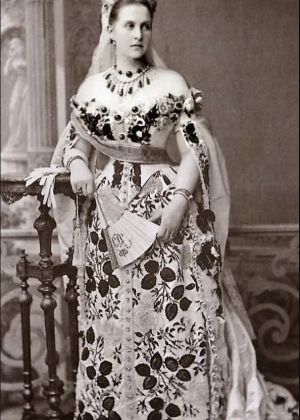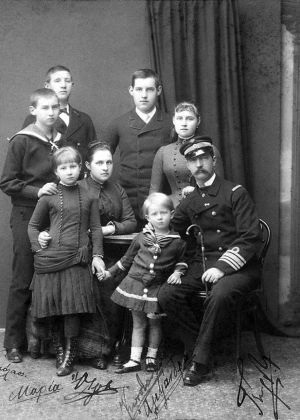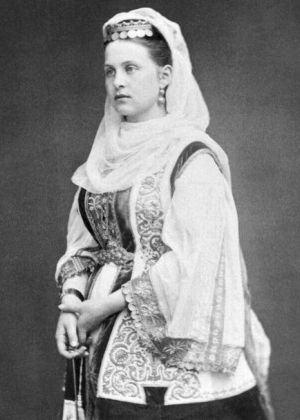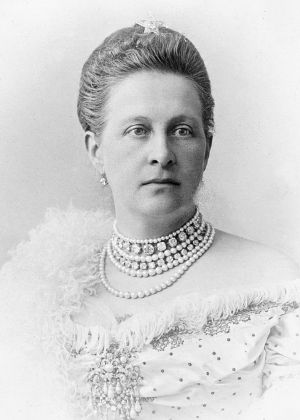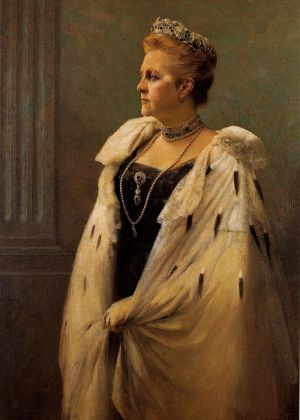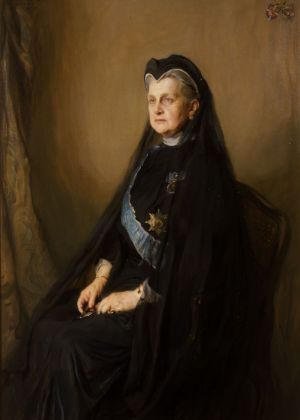Queen Olga
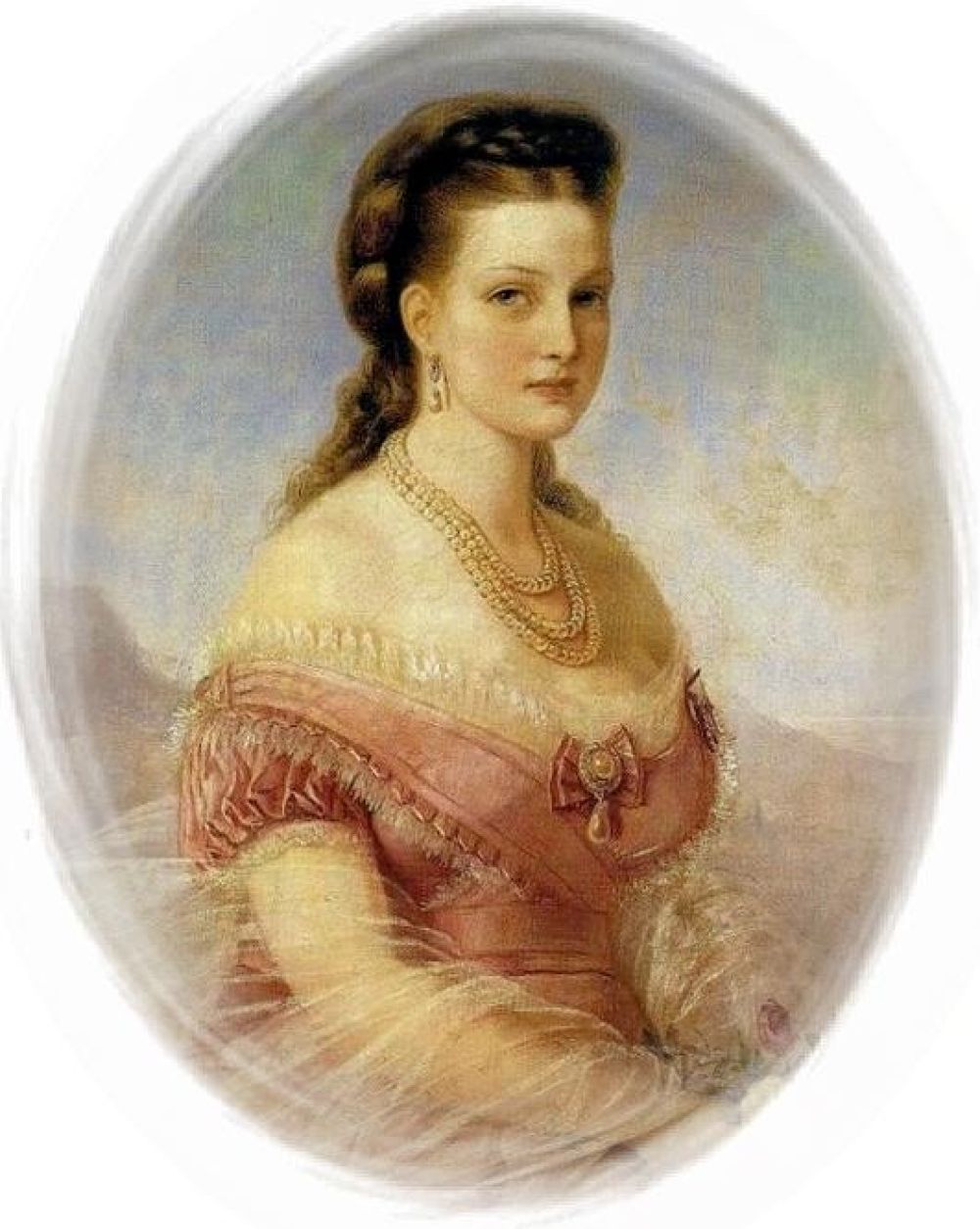
The period of the reign of George I and his consort Olga constitutes, without any doubt, a special chapter in Greek history. The royal couple is integral part of great historic events that have shaped the course of the country. The particular case of the second and longest-reigning Queen of the Hellenes is worth mentioning. Olga managed, in a most intense and dense in events historic environment, to be loved and cherished by the people, more than any other queen before or after her.
Olga Konstantinovna was born in Saint Petersburg on August 22, 1851. She was the second of the six children of Grand Duke Konstantin Nikolayevich (second son of Czar Nicholas I) and Princess Alexandra-Josephine of Saxe-Altenburg. Officially, she was originated from the House of Schleswig-Holstein-Gottorp, yet she is still deemed to originate from the House of Romanov, for symbolic reasons.
Queen Olga is described by various sources as humble and modest, showing affection and solidarity, as well as gracious and tender. Her mother writes distinctively to the governess of her daughter: “(…) She is so tender, cheerful, simple and obedient (…) I wish Vera [her sister] takes after her and hopefully not give you any trouble (…)”.
An important landmark in her life seems to be the move and settlement of her family in Poland. Her father was appointed Viceroy there, in 1863. Young Olga witnessed tremendous unrest in the area, aiming actually at her father, whom they attempted to assassinate twice. Such events shattered the young Grand Duchess and shaped the character of the future queen.
She was very religious from a very young age. Perhaps this was also one of the reasons why the Greek society embraced her so whole-heartily: a Christian Orthodox queen would ascend the throne. Her private secretary, J. Karolou, writes in her memoirs: “(…) From the very beginning, the whole nation felt very affectionate towards Queen Olga, because Greek people saw in her the embodiment of their dreams through the marriage of the King with an Orthodox Princess”.
Indeed, in the year 1867 the young – at the time – King George I of Greece visits St. Petersburg and is introduced to the sixteen-year-old Olga. Having both reached the age of marriage and given the very interesting perspective of establishing marital bonds between the two Houses, their wedding is decided (albeit some reservations from Grand Duke Konstantine). This was not, however, a marriage of interest, since genuine interest was shown by both youngsters. Actually, through Olga’s personal correspondence, it can be deduced that, ever since the onset of their official acquaintance, she desires to be wed to George. Although her primal goal is neither to become a queen or leave Russia, yet she agreed to both concessions in order to marry George. The couple gets engaged in May 1867 and they get married in October of the same year, in a grandiose ceremony held in the Winter Palace in St. Petersburg. Some months later, in Athens, their first child is born, Crown Prince Constantine.
The advent of the couple in Athens coincided with some unpleasant incidents. The capital city was flooded, at the time, with fugitives from Crete. At this precise point we can mark the commencement of the long charity activity of the new queen in the country. In collaboration with the Metropolitan of Athens Theoklitos, she took the lead in the care of the suffering women and children from Crete. Her kind character and sensitivity towards the plight of the Greek people were quickly noticed and it seems that this was appreciated and reciprocated, even during difficult political circumstances at a later stage.
On the occasion, therefore, of her arrival in Greece and the events that followed, a new substantial chapter starts, directly linked with her royalty. Her charity work is remarkable and deeply traced in collective memory since – even to date – many of her projects remain visible and operative, especially in the city of Athens.
The Philanthropic Work of Queen Olga
We can indicatively distinguish the charitable projects in three categories: (a) her work promoting women’s education and vocational training, (b) erection of hospitals and (c) other social establishments.
Her basic and primary works are related with the education of girls and their vocational training in two directions: teachers, in order to staff education, and nurses, in order to service in public health care. Establishing, in 1872, the Ladies’ Educational Association is considered really pioneering. This was the first women’s charity club, aiming at the rise of women’s educational and living standards. Soon, the Association came under the aegis of the young queen and actually her relation with the latter was also connected with other works aiming at promoting women’s literacy. Such works, for instance, were the erection of the Arsakeion Girls’ School and the funding of the Amaleion Orphanage / boarding school (a project launched at the time of Queen Amalia, hence its name). All educational units connected with the name of Queen Olga directly concerned the female gender, a pioneering event at the time. Those units have assisted scores of women of every age to become literate, against all odds given their family origins, and actually become an active part contributing to society.
There follows the health sector. In 1875 the “School of Training Female Nurses” is established. This School produces a significant number of nurses, ready to staff health units. In less then 10 years the “Evaggelismos” hospital was founded. J. Karolou writes “(…) Evaggelismos was the apple of her eye par excellence and she lived to see her dream come true”.
The second hospital to be erected in her name was the Russian Hospital (currently the Piraeus Naval Hospital), commemorating the daughter of the royal couple Alexandra, who died at a very early age. This hospital became one of the main health care centers for Russians in Greece. It remained steadily open and accessible, however, by the slum dwellers of the poor Piraeus neighborhoods, offering medical care, food and accommodation to whomever in need. J. Karolou offers indicatively her testimony: “(…) But what greatly served the neighboring city, Piraeus, (…) was the adjacent out-patient building of the Russian Hospital. Poor people of both genders and regardless of age would turn out there on a daily basis (…) and not only were they examined by distinguished doctors for free but they were also given medicines and bandages and artificial limbs, in the case of amputated ones; everything was offered for free to the attending patients, and those who were heavily ailing were admitted for free hospitalization (…) until their full convalescence”.
In 1915 an adjacent adjunctive building is funded next to the Eye Clinic of Athens - the legendary mid-byzantine-era building on Panepistimiou st. - in order to accommodate its increased needs, and is still in operation to date.
The medical office erected next to the Tatoi royal palace is also worth mentioning. The dispensary was operated by the royal doctor, but beyond the needs of the royal family it also served any resident of the area who happened to be in need; a fact recorded through a plethora of photos and written sources.
The most significant charity work, however, is related with the active personal involvement of the Queen with these charitable institutions. Olga would work, for instance, quite often in these medical units. During the acute war periods of Greece (i.e. the unfortunate 1897 Greek-Turkish war and the 1912-1913 Balkan Wars) Olga used to serve in person in the treatment of war casualties, both in Evaggelismos hospital and Tatoi. According to a testimony of the times: “(…) Q. Olga worked then (…) assisted by her daughters-in-law and many society ladies, who did not hesitate to promptly wear the nurse’s attire and serve tirelessly the boys of the Country (…)”
The other social establishments worth mentioning include the first women’s prisons and the first juveniles’ reformatory (with the financial aid of George Averof).
One of her most important works – which was actually extremely controversial at the time and even reprehensible and frowned upon by a large part of the conservative society – was the translation of the New Testament in modern Greek. The acute conflict on the matter passed down in History as the “Evaggelika” [The Gospel riots]
In summary, in 1898 the Queen made the decision to have the Gospel rendered in a comprehensible, plain language form, causing the wrath of ancient Greek lovers. In 1901 the Gospel is translated again by Alexandros Pallis (on the Queen’s expenses) “in the colloquial Greek language” and originally circulated in a limited number of copies among the Greeks of the Diaspora. The situation exacerbated when the newspaper “Akropolis” decided to publish this work in serial form, invoking the need for every Greek to have access to the word of God in a comprehensible language. The work was completed with the consent of the Archdiocese and the Rector of the University School of Theology. The translation of the Gospel came at a peculiar moment of intense and fierce social unrest throwing the advocates of “Demoteke” [Demotic, the spoken language] against those of “Katharevoussa” [post-classical ancient Greek]. At the same time, however, the defeat of Greece in the Greek-Turkish war (1897) was still a fresh wound and one of its many impacts was the excessive rise of nationalism. Nevertheless, this work, as proven through time, was a trailblazer and is considered one of the most important and impactful on society works of Queen Olga.
Within a moment the situation of the royal family will dramatically change on 18 March 1913, when King George is shot dead by A. Schinas in Thessaloniki. He is succeeded in the throne by their son, Crown Prince Constantine I. Olga will suddenly pass from the role of the Queen to that of the Queen Mother. This shift was abrupt. The events that followed were ominous for the royal family, Greece and the entire Europe. Olga saw world-changing events unfolding before her eyes: the outbreak of the 1st World War, the Russian Revolution - (it so happened that she was present and actually held hostage for some time by the Bolsheviks) - as well as the bloody ethnic conflict that erupted in Greece. The divide led to the ousting of Constantine and the accession to the throne of the second-born son, Alexander. King Alexander died very suddenly in 1920. The only member of the royal family allowed by the Venizelos government to return to the country and pay last tribute was Queen Mother Olga. The royal family was permanently exiled after the Asia Minor disaster tragedy in 1922 and Olga never again returned to Greece.
Queen Olga remained committed to her charity work and her family till the end. During her life period the Greek people went through a lot and turned against the monarchy on many occasions, yet no one could ever imply that she has not been loved by her subjects. She did many memorable and beautiful works, out of respect for the country she came to reign over – at a very tender age – by the side of George. Amongst others, she wanted to preserve facets of the culture of Greece, as seen in her love for the traditional national costumes that had gradually started disappearing in her time. A big collection of dolls dressed in the various traditional local costumes made her rejoice like a little girl. It is typically written in various sources of the time: “She was always fascinated by the Greek local peasant attires of men and women alike and the Queen got the idea to preserve their genuine, original style (…). [The] inspiration of the Queen was successful, and I can not forget, to date, the childlike joy the Queen showed when the first parcel arrived from Skyros (…)”.
Olga Kostantinovna was a genuinely selfless woman who constantly offered to society, much more than she herself could have fathomed perhaps. She was never mentioned as an active political person, despite the institutional title she held. She played her “political” role up to a certain point, both desired and feasible. The Queen and Queen Mother passed away in Rome on 18 June 1926 at the age of 74 and was buried in Tatoi, next to her beloved husband George, with whom she had 8 children and many grand-children. Her last grand-son who passed away only recently was the renowned novelist Prince Michael of Greece (Michel de Grèce ; 1939-2024), son of Prince Christophoros who was the fifth son of the royal couple.
